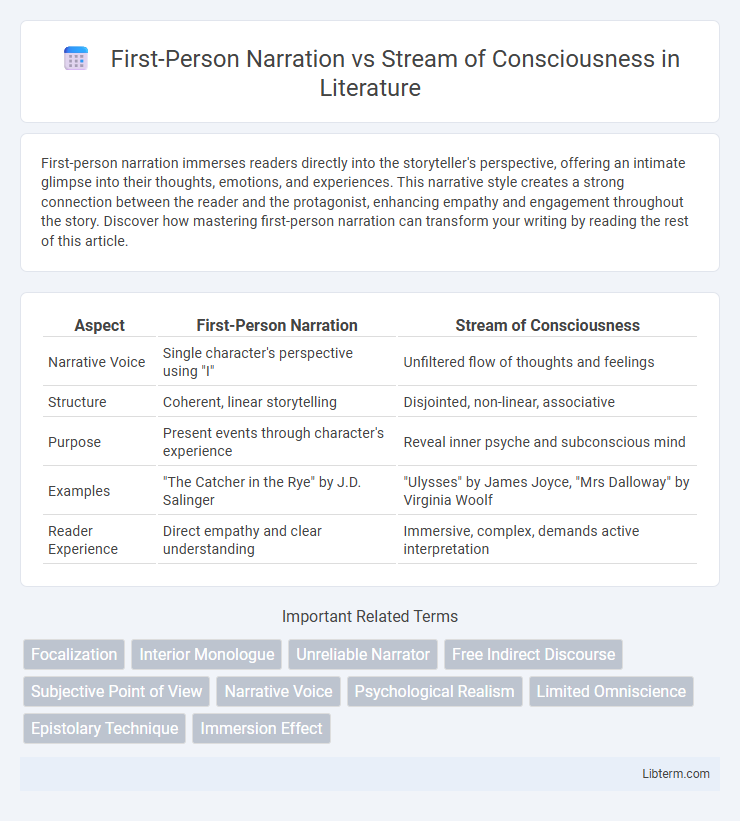First-person narration immerses readers directly into the storyteller's perspective, offering an intimate glimpse into their thoughts, emotions, and experiences. This narrative style creates a strong connection between the reader and the protagonist, enhancing empathy and engagement throughout the story. Discover how mastering first-person narration can transform your writing by reading the rest of this article.
Table of Comparison
| Aspect | First-Person Narration | Stream of Consciousness |
|---|---|---|
| Narrative Voice | Single character's perspective using "I" | Unfiltered flow of thoughts and feelings |
| Structure | Coherent, linear storytelling | Disjointed, non-linear, associative |
| Purpose | Present events through character's experience | Reveal inner psyche and subconscious mind |
| Examples | "The Catcher in the Rye" by J.D. Salinger | "Ulysses" by James Joyce, "Mrs Dalloway" by Virginia Woolf |
| Reader Experience | Direct empathy and clear understanding | Immersive, complex, demands active interpretation |
Introduction to Narrative Techniques
First-person narration provides a direct voice from the protagonist, offering insight into their thoughts, feelings, and experiences through a structured and coherent narrative framework. Stream of consciousness, however, delves deeper into the character's psyche by presenting a continuous flow of thoughts, sensations, and memories, often fragmented and nonlinear. Both techniques enhance narrative intimacy but differ in clarity and psychological depth, affecting how readers perceive and engage with the story.
Defining First-Person Narration
First-Person Narration is a storytelling perspective where the narrator recounts events from their own point of view, frequently using pronouns like "I" and "we," which creates a direct connection between the reader and the narrator's experiences. This narrative style offers intimate insight into the narrator's thoughts, emotions, and motivations, fostering a personal and subjective portrayal of the story. Unlike Stream of Consciousness, which captures the narrator's unfiltered and often nonlinear flow of thoughts, First-Person Narration typically maintains a more structured and coherent narrative.
Exploring Stream of Consciousness
Stream of consciousness narration delves deeply into a character's inner thoughts and feelings, offering an unfiltered and often nonlinear portrayal of their mental state. This technique captures the continuous flow of perceptions, emotions, and memories, mimicking the way the human mind processes information in real time. Distinguished from traditional first-person narration, stream of consciousness emphasizes raw, spontaneous inner dialogue, enhancing psychological depth and intimacy in literary works.
Key Differences Between the Two Styles
First-person narration presents a structured, coherent perspective through a single character's voice, providing clear insights into their thoughts and experiences. Stream of consciousness captures the unfiltered, often fragmented flow of a character's inner thoughts and sensations, mimicking the natural progression of the mind. Key differences include the level of organization, with first-person narration offering clarity and narrative coherence, while stream of consciousness emphasizes spontaneity and psychological depth.
Emotional Depth and Subjectivity
First-person narration offers a clear emotional depth by providing direct access to the protagonist's thoughts and feelings, enhancing subjectivity through a personalized perspective. Stream of consciousness delves deeper into the mind's raw, often fragmented flow, capturing intense emotional states and subjective experiences in real time. This technique creates an immersive, nuanced portrayal of consciousness that surpasses traditional narrative boundaries.
Narrative Reliability and Perspective
First-person narration offers a subjective viewpoint where the narrator's reliability can vary, shaping the reader's trust in the storyline. Stream of consciousness delves deeper into a character's internal thoughts, often presenting fragmented and non-linear perspectives that challenge traditional narrative reliability. Both techniques prioritize intimate access to the protagonist's mind but differ in clarity and control over the narrative's trustworthiness.
Literary Examples of Each Technique
James Joyce's "Ulysses" exemplifies stream of consciousness through its fluid, unfiltered portrayal of a character's inner thoughts, breaking traditional narrative structures. In contrast, Harper Lee's "To Kill a Mockingbird" employs first-person narration, providing a clear, reflective perspective through the protagonist Scout's voice. Virginia Woolf's "Mrs. Dalloway" also showcases stream of consciousness, weaving internal monologues with external events to deepen psychological insight.
Impact on Reader Engagement
First-person narration creates a direct connection between the protagonist and reader, fostering empathy through personal insights and emotional depth. Stream of consciousness enhances this engagement by providing raw, unfiltered thoughts, replicating the character's mental flow and intensifying immersion. Both techniques deepen reader involvement but vary in clarity and emotional resonance, affecting how readers perceive and relate to the narrative.
Choosing the Right Style for Your Story
Selecting the appropriate narrative style hinges on the emotional depth and perspective required for your story. First-person narration offers a clear, direct voice, immersing readers in the protagonist's thoughts and experiences. Stream of consciousness delves deeper into a character's psyche, capturing raw, unfiltered mental processes, ideal for exploring complex inner conflicts and fragmented realities.
Conclusion: Which Technique Suits Your Writing?
First-person narration offers a clear and direct perspective, making it ideal for writers aiming to establish a strong, relatable character voice with structured storytelling. Stream of consciousness suits experimental narratives that delve deeply into a character's inner thoughts and emotions, providing an immersive but often nonlinear experience. Choosing the right technique depends on the desired depth of psychological insight and the reader's engagement level within the narrative structure.
First-Person Narration Infographic

 libterm.com
libterm.com